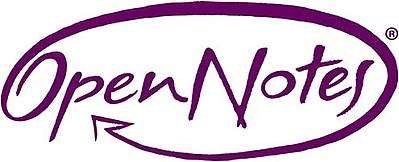OpenNotes

Headquarters: Boston, MA
Reach: International
Type: Social Movement
Website: www.opennotes.org
OpenNotes is an international movement dedicated to making health care more open and transparent by encouraging doctors, nurses, therapists, and other health care professionals to share visit notes with patients, facilitating patients' legal right to access to their own medical record.[1] Patients who have access to their full medical record, including their notes, report understanding their conditions better, feeling more in control of healthcare decisions, and being able to identify errors and inaccuracies in the record.[2]
Background
Co-founded by Tom Delbanco and Jan Walker of Harvard Medical School and Beth Israel Deaconess Medical Center[3][4] OpenNotes began as a demonstration project involving 105 primary care doctors at Beth Israel Deaconess Medical Center in Boston, Geisinger Health in rural Pennsylvania, and Harborview Medical Center, a safety net hospital in Seattle. 20,000 patients were invited to read their notes on each health system's online patient portal.[5] The overwelmingly positive results of the study funded by the Robert Wood Johnson Foundation[6] were published in 2012 in the Annals of Internal Medicine. Researchers reported that at the year's end, 99% of patients surveyed wanted to continue accessing their notes, 85% said open notes helped them feel more in control of their care, 70% of patients taking medications reported better adherence, and 85% of patients said the availability of open notes would affect their future choice of doctor. Doctors reported little change to workflow, and none chose to discontinue participation.[5]
In 2015 the Gordon and Betty Moore Foundation, the Peterson Center on Healthcare, and the Cambia Health Foundation joined the Robert Wood Johnson Foundation and announced new funding to support innovation, research, and the goal of spreading OpenNotes nationwide.
History
In 1991 the Institute of Medicine (IOM) released a report, “The Computer-Based Patient Record: An Essential Technology for Health Care.” The report made a strong case for electronic health records, saying they are essential to improving health care quality and safety.
The Health Insurance Portability and Accountability Act was enacted by Congress and signed into law by President Clinton in 1996. An important component of this complicated act was the establishment of national standards for Electronic Health Care mandating that patients nationwide have the right to inspect, review, and receive copies of their medical records. This eliminated a critical barrier to access and eased the path toward open notes.
By the late 1990's health systems and technology companies had begun to develop and adopt secure online websites called patient portals, which allow patients to access some of the personal health information in their medical record. Using the portals, patients can read information such as medication lists and test results, and many can send secure email to their health care team.
Health Systems That Share Visit Notes with Patients
- Beth Israel Deaconess Medical Center[5]
- Geisinger Health System[5]
- Kaiser Permanente Northwest[7][8]
- Legacy Health[7][8]
- Mayo Clinic[5]
- MD Anderson Cancer Center[5]
- Oregon Health & Science University[7][8]
- The Portland Clinic[7][8]
- The Vancouver Clinic[7][8]
- U.S. Department of Veterans Affairs (VA)[5]
Research
What patients value about reading visit notes: a qualitative inquiry of patient experiences with their health information Gerard, Macda, et al., JMIR, July 2017
Patients Typing Their Own Visit Agendas Into an Electronic Medical Record: Pilot in a Safety-Net Clinic Anderson, McHale, et al., Annals of Family Medicine, March 2017, ePub
Your Patient Is Now Reading Your Note: Opportunities, Problems, and Prospects Klein, Jared W. et al., The American Journal of Medicine, October 2016, Volume 129, Issue 10, 101 -1021
When doctors share visit notes with patients: a study of patient and doctor perceptions of documentation errors, safety opportunities and the patient–doctor relationship Bell, Sigall, K. et al., BMJ Qual Saf doi:10.1136/bmjqs-2015-004697
Sharing Physician Notes Through an Electronic Portal is Associated With Improved Medication Adherence: Quasi-Experimental Study Wright, Eric et al., JMIR 2015;17(10):e226
Let’s Show Patients Their Mental Health Records Kahn, Michael W. et al., JAMA. April 1, 2014 311(13):1291-1292
Inviting Patients to Read Their Doctors’ Notes: A Quasi-experimental Study and a Look Ahead Delbanco, Tom et al., Annals of Internal Medicine. October 2, 2012 157(7):461-470
References
- ↑ Versel, Neil (Feb 4, 2014). "OpenNotes Helps Keep Patients Informed and Engaged". U.S. News & World Report. Retrieved 25 August 2014.
- ↑ Rabin, Roni Caryn (Jan 9, 2012). "Project Puts Records in the Patients' Hands". The New York Times. Retrieved 26 September 2017.
- ↑ "Tom Delbanco, MD". OpenNotes. Retrieved 11 March 2016.
- ↑ "Jan Walker, RN, MBA". OpenNotes. Retrieved 11 March 2016.
- 1 2 3 4 5 6 7 Walker, Jan; Darer, Jonathan D.; Elmore, Joann G.; Delbanco, Tom (2014). "The Road toward Fully Transparent Medical Records". New England Journal of Medicine. 370 (1): 6–8. doi:10.1056/NEJMp1310132. ISSN 0028-4793. PMID 24304001.
- ↑ Robert Wood Johnson Foundation (2014). "OpenNotes - Robert Wood Johnson Foundation". rwjf.org. Retrieved 25 August 2014.
- 1 2 3 4 5 Harshman, Marissa (April 8, 2014). "Patients to soon have easier access to their doctors' notes". The Columbian. Retrieved 25 August 2014.
- 1 2 3 4 5 Miliard, Mike (April 11, 2014). "Kaiser, others open notes to patients". healthcareitnews.com. Retrieved 25 August 2014.